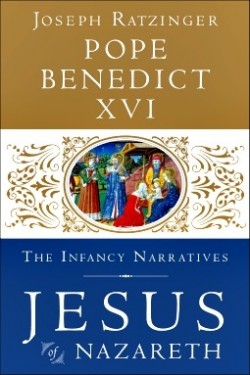
I was overjoyed when I got the third volume of Jesus of Nazareth, Pope Benedict’s study of the Gospels. But I must confess I was a little sad at the same time. I knew this would be the third and final volume. I’ve loved these books; and, as I’ve said before to anyone who’ll listen, I believe they are the great legacy of Pope Benedict’s pontificate, just as the theology of the body was the great legacy of Pope John Paul’s reign. Pope Benedict has been quietly making modest, yet revolutionary statements about the way we should see Jesus in the New Testament.
His insights are new because they’re the Gospel truth, and the Gospel is always news. They’re original and startling not because Pope Benedict is making any innovations, but because he’s genuinely bringing us back to the origins of Christianity — so that we can sense the excitement of the first proclamation, just as the Apostles did.
I didn’t want these books to stop. Ever.
I still don’t, but Volume III itself soon drove away any sense of sadness I’d had. Like the other two volumes, it’s a beautiful exploration of the historical and spiritual depths of the Gospel texts.
From the beginning he makes it clear that, when we read of the birth of the Messiah, we are dealing not in myths, legends, or folk tales. We are reading history: “what Matthew and Luke set out to do, each in his own way, was not to tell ‘stories’ but to write history, real history that had actually happened, admittedly interpreted and understood in the context of the word of God.”
This is such a far cry from what we have come to expect from biblical studies. For decades in academia even Catholic scholars have shied away from affirming the historicity of the Gospels’ infancy narratives.
We can be grateful that the Apostles had no such scruples. Nor did the Church Fathers. Nor does Pope Benedict. Though the Gospel is indeed rich in allegorical meaning, it is first of all history. God has fashioned the allegory not simply out of words, but out of His creation. God writes the world the way human authors write words. Spiritual truths are everywhere to be found in the events at the beginning of the Gospels; but the events are nonetheless real and nonetheless important.
The events challenge us, just as they challenged the characters whose story they tell. Pope Benedict sees this in the lives of Blessed Virgin Mary and St. Joseph, St. Elizabeth and Zechariah.
Sacred history records their lives so that we might learn from them. Pope Benedict makes the lessons abundantly clear. For example, he shows that Mary and Zechariah respond to the angelic annunciations in different ways. Zechariah asks, “How shall I know?” in a way that “reflects his own doubt and desire for certitude, which results in mute silence, on his part.”
“On the other hand, Mary’s reply (‘How shall this be?’) expresses her sense of wonder, which results in her own divine maternity, illumination, and the joy of her Magnificat.”
Many years before he was pope, Cardinal Joseph Ratzinger observed that biblical scholarship, like Zechariah, had been reduced to silence by its desire for certitude. “By its very nature, historical interpretation can never take us beyond hypotheses,” he wrote. “After all, none of us was there when it happened.”
Something more is required for those of us who would be Christians — whether we are teachers, preachers, or lay disciples. “Whoever reads Scripture in faith as a Bible must make a further step.” We must step out in faith. “Faith gives us knowledge of something more than a hypothesis; it gives us the right to trust the revealed Word as such.” It gives us the right to respond, like Mary, in a trusting way.
How appropriate that this book should appear in the Church’s Year of Faith.
Its lessons are joyful, though they are not always easy for us to take in. “God is love, But love can be hated when it challenges us to transcend ourselves. It is not a romantic ‘good feeling’… it is not about basking in self-indulgence; on the contrary, it is a liberation from self-absorption. This liberation comes at a price: the anguish of the Cross.”
The birth of the Messiah liberates us from selfishness. Jesus draws us together around his crib, as he once (really) drew the Magi and the shepherd and even the angels.
I am grateful that he has drawn you and me to share the mission of the St. Paul Center. Let’s continue to pray for one another and support one another in the Year of Faith—and through all our years of faith.


